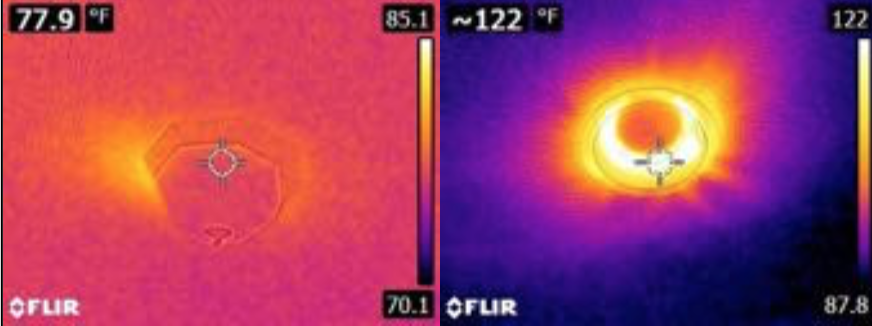I’m Harper, a BPI Certified Building Analyst and Envelope Professional in Asheville, with a degree in Appropriate Technology from Appalachian State University (woop! woop!). I wouldn’t be a good building performance specialist without adding my contribution to the radiant barrier saga in Western North Carolina.
Radiant barriers are a hot topic in the insulation world. They are a shiny, flashy addition to a home’s energy efficiency upgrades, (see photos of our installations), but I often see them installed where they have little to no potential for savings. Radiant barriers have become popular in recent years. I’ll start by laying out the reasons you should consider a radiant barrier in your attic:
- Your duct work is in the attic and your summer cooling bills are high.
- Your attic is used for storing important items, or you go up there regularly in the warmer months.
- You have knee wall attics and you have room discomfort and/or high energy bills
The problem I have is seeing them used in many, many, (certainly, too many) ways. Radiant barrier on the attic floor, radiant barrier on top of the insulation, radiant barrier on the roof sheathing, radiant barrier on foam board insulation, radiant bubble foils – the list goes on. I am here to clarify how radiant barriers are effective, beginning with the lessons of how they have been installed wrong leading to more problems instead of savings in our mixed-humid climate here in WNC.



Hot attic air forcing its way into the home in the summer at ceiling lights and other gaps. This is an air leakage issue not a hot attic issue.
Mistake #1: You Never Needed a Radiant Barrier
If you want a radiant barrier, of course, someone will be glad to install that for you. If you are looking to cool your home and reduce energy bills a radiant barrier could help. Now, if you haven’t had a BPI Certified Professional investigate your ductwork in the attic, air leaks in the ceiling, and/or existing insulation levels over the ceilings – you need to get that all evaluated first. Conservation Pros usually solves the issues of the hot home, high cooling bills, etc. by sealing up all attic air leaks, sealing ductwork, and/or adding insulation. The attic still gets very hot, but your building is weatherized and protected from that heat. Problem solved, no radiant barrier.
Mistake #2: Radiant Barrier on the attic floor – Case study
A radiant barrier is very easy to lay over existing insulation and can be done in hours instead of doing it the right way (on the rafters). With the radiant barrier on the attic floor, it will reflect the attic heat away from the ceiling, but it will do nothing to cool the attic. The weight of the radiant barrier compresses the insulation it is laid over too, reducing the insulation’s R-value. We have removed a radiant barrier from an attic where the homeowner tried this method, and it didn’t work. They wanted to make the house cooler in the summer. When it didn’t work another contractor said they just needed more insulation installed on top of the radiant barrier. Warm air with humidity from the home was trapped under that metal coated liner and while the insulation that was on top of it was dry to the touch, the insulation under the radiant barrier was sopping wet. As we climbed through the attic that summer it was almost impossible to find joists to walk or crawl over, and when you found them you couldn’t even get traction because the radiant barrier was on top of them. A dangerous and costly situation for those homeowners. In the end, we air sealed the ceiling at all top plates, electrical, and plumbing penetrations, removed the old radiant barrier which was ruined from moisture, and leveled out the old insulation. We also sealed some leaky ductwork, and the house was no longer uncomfortable in the summer or the winter. A notable issue that can occur in this scenario is the radiant barrier on the floor of the attic will collect dust. What was once very reflective is now much less so, and so the benefits of keeping heat off the attic ceiling were short-lived.
Mistake #3: Spray Applied Radiant Barrier on Roof Deck
A spray applied radiant barrier can be installed that coats the rafters and roof deck from the attic side. The process requires mechanical ventilation for off-gassing of the reflective paint. This study conducted by the DOE found the radiant barrier made little difference. A waste of time, materials, and money to get a 6 degree reduction on a day when the attic usually hits 120F.
The Right Space and Place for Radiant Barriers
Moving past the stories and wasted investments of installing radiant barriers on the attic floor, there is good news for the radiant barrier industry in this area. Aside from its development by NASA for space exploration, radiant barriers do have good uses and make big differences in the home performance industry. Radiant barriers are the shiny surface you see on ducts which helps keep them cool. They can go under the rafters to really reduce attic temperatures more significantly than any other method (yes, this includes solar and powered roof fans, which deserve their own article). Reducing attic temperatures can take a load off the HVAC unit in the attic, and all the duct work. This can result in a 20% energy savings in the summer months or more in cases around WNC.
But, the best use for radiant barriers in WNC is …
KNEE WALLS!
Walls of your home that have attics on the other side were neglected for many years in the building industry. Properly installed and applied, knee walls are where radiant barriers really shine! In the past several years we have been required to cover them, but aside from that, knee walls are one of the single largest contributors in WNC to discomfort and energy loss. The uncomfortable bonus room, the too warm or too cold finished out attic space, they have knee walls that cause those issues. Radiant barriers in knee wall attics are applied as a coated foam board insulation that goes over the attic side of the wall. The foam board is completely sealed to keep attic air out, and the wall cavity insulation is protected from radiant heat.

At Conservation Pros, we have used our knowledge of building in WNC to help homeowners make that bonus room or “FROG” (Family Room Over Garage) livable with great success!




